Here are the latest oil production numbers from the EIA. All data is in thousand barrels per day unless otherwise noted.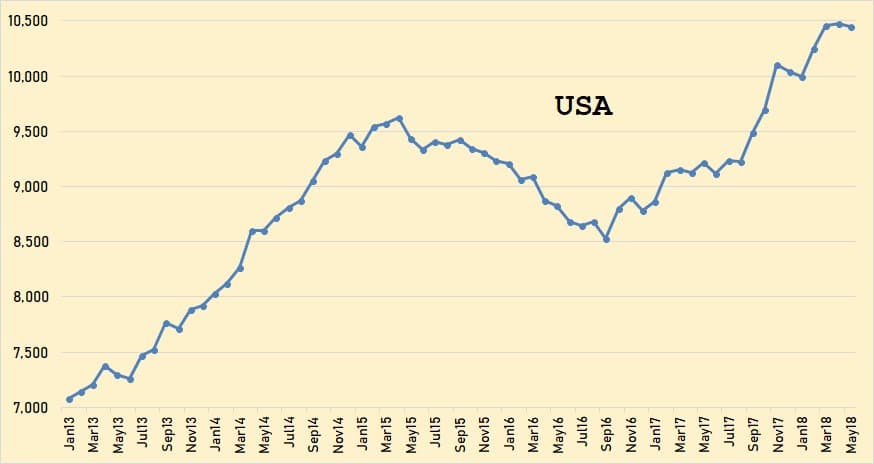
(Click to enlarge)
The USA through May 2018. The upward surge has stalled for the last two months. U.S. production was down 30,000 bpd in May.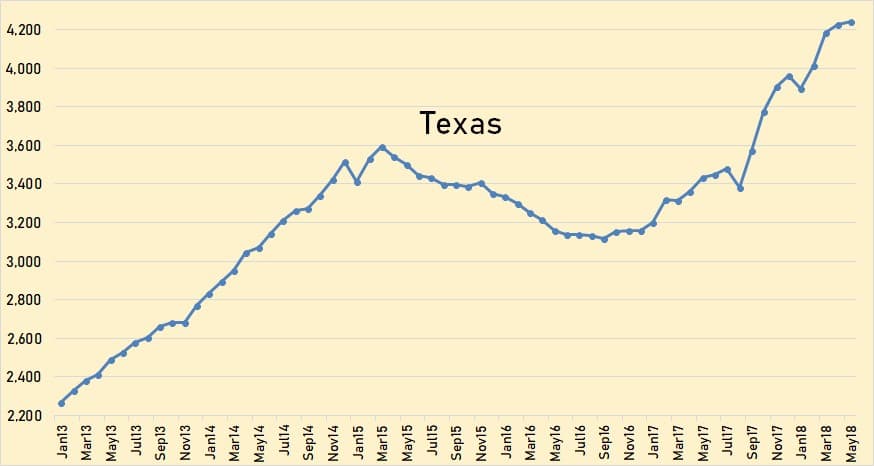
(Click to enlarge)
It is a little astonishing how close the Texas chart resembles the USA chart. Texas is, by far, the USA’s largest producer. As Texas goes, so goes the USA. Texas production was up 20,000 bpd in May.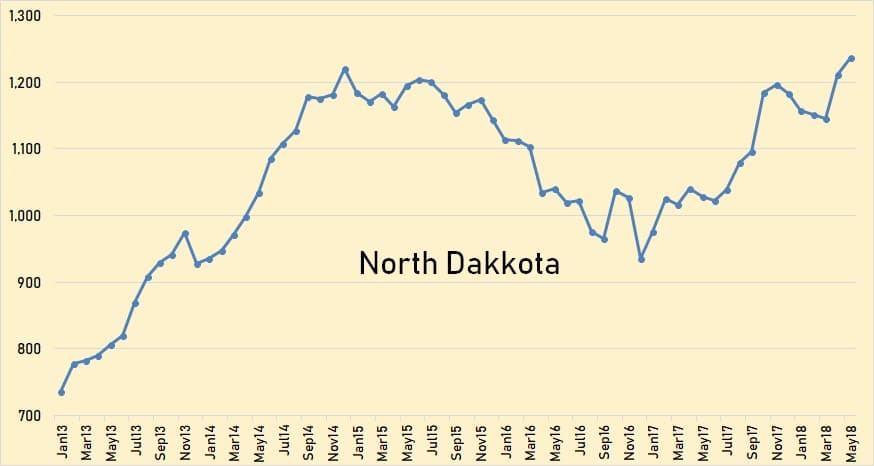
(Click to enlarge)
North Dakota production has increased significantly in the last two months. They were up 67,000 bpd in April and up another 25,000 bpd in May.
(Click to enlarge)
Gulf of Mexico production was down 99,000 bpd in April and down another 75,000 bpd in May.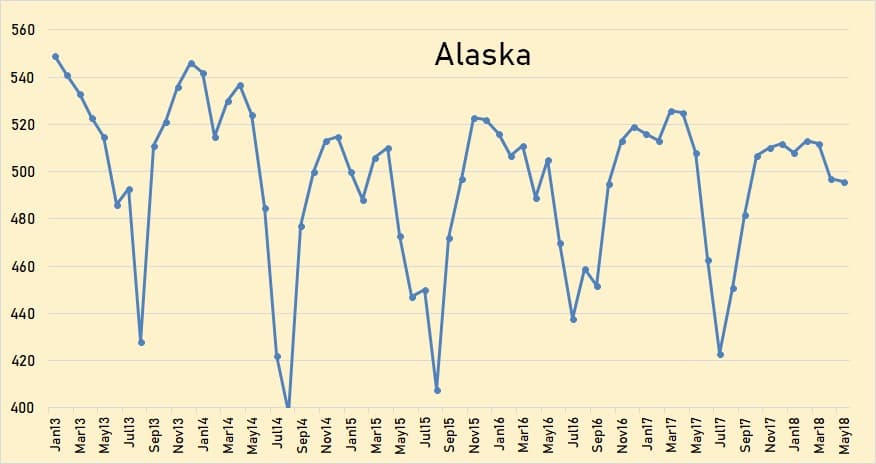
(Click to enlarge)
Alaska was down only 1,000 bpd in May but that was 12,000 bpd lower than last May. They are now entering the maintenance season. Expect huge drops in June and July.
(Click to enlarge)
The EIA data in this chart is through April and the National Energy Board data is estimated through December 2018. The EIA data is usually lower than the NEB data but they both agree on April production.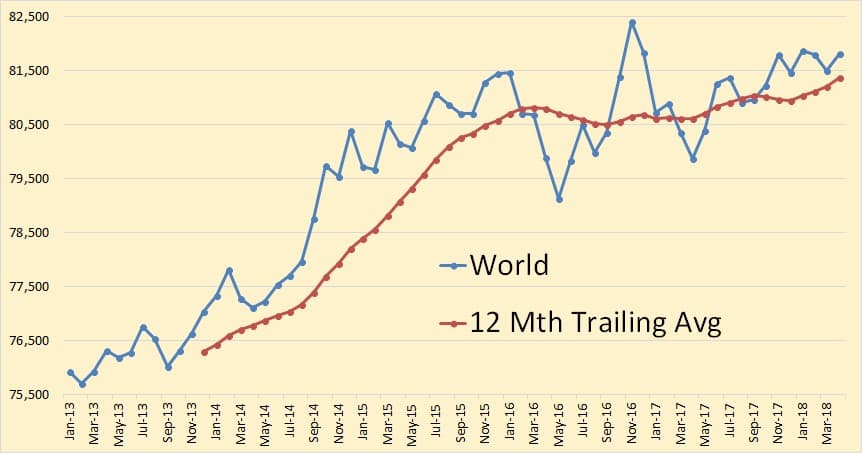
(Click to enlarge)
World crude oil production was up 326,000 bpd in April.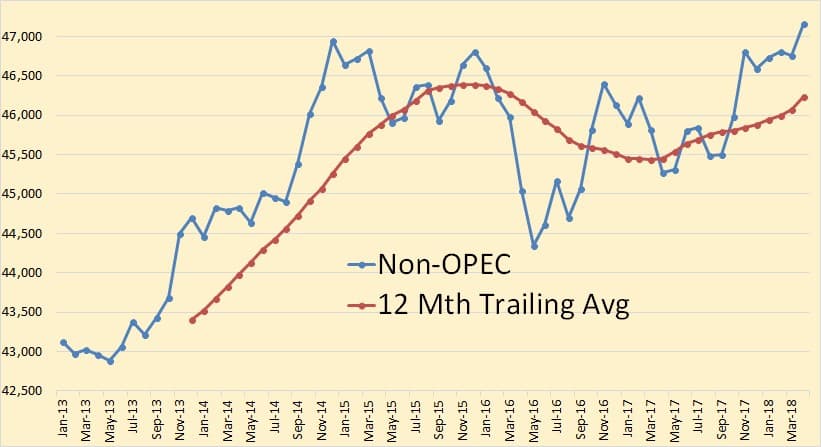
(Click to enlarge)
Non-OPEC production reached a new peak in April, up 405,000 bpd to 47,159,000 bpd. Most of that increase was Canada, up 317,000 and the U.K., up 111,000 bpd.
Here I am adding a few charts and comments from ExxonMobil’s 2018 Outlook for Energy: A View to 2040. Their text is in italics. Any bold in their text is mine.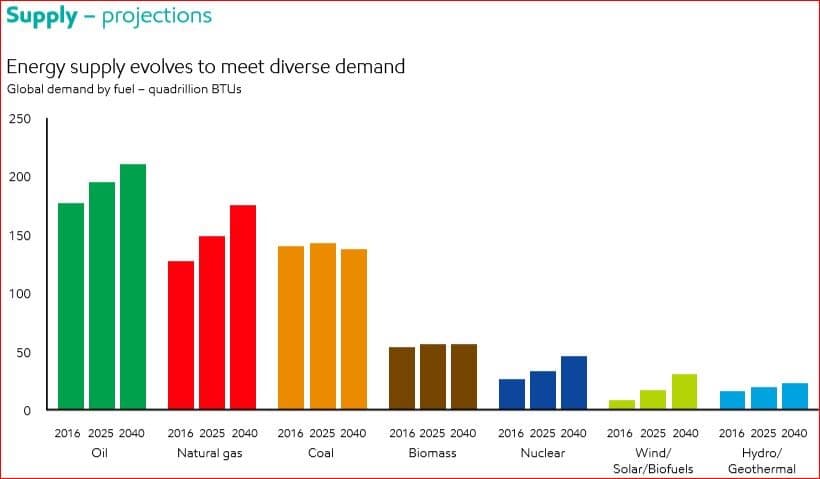
(Click to enlarge)
• Technology improvements lead to wind, solar and biofuels increasing, with a combined growth of about 5 percent per year
• Non-fossil fuels reach about 22 percent of total energy mix by 2040
Related: The Three Best Oil Majors Of 2018
• Oil continues to provide the largest share of the energy mix; essential for transportation and chemicals
• Natural gas demand rises the most, largely to help meet increasing needs for electricity and support increasing industrial demand
• Oil and natural gas continue to supply about 55 percent of the world’s energy needs through 2040
• Coal’s share falls as OECD countries and China turn to lower-emission fuels
• Nuclear demand grows 70 percent between 2016 and 2040, led by China
• Wind, solar and biofuels reach about 5 percent of global energy demand
They assume that supply will always evolve to meet demand.
(Click to enlarge)
This is what they say we will need in 2040 and will therefore be delivered by technology.
(Click to enlarge)
And here is where all that oil will come from. North America is the U.S. and Canada. They count Mexico as part of Latin America. In 2040 they have total North American conventional production down to about 3.5 million barrels per day. They have at about 12 million bpd and oil sands at about 4.5 million bpd as best as I can eyeball the chart.
They have almost all conventional oil coming from the Middle East and Russia/Caspian. Caspian is mostly Azerbaijan.
• Global liquids production rises by 20 percent to meet demand growth
• Technology innovations lead to growth in natural gas liquids, tight oil, deepwater, oil sands and biofuels
• Technology enables efficient production from conventional sources, which still account for more than 50 percent of production in 2040
• Most growth over the Outlook period is seen in tight oil and natural gas liquids, which reach nearly 30 percent of global liquids supply by 2040
• Continued investment is needed to mitigate decline and meet growing demand
• Liquids trade balances shift as supply and demand evolve
• North America swings to a net exporter as shale growth continues
• Latin America exports increase from deepwater, oil sands and tight oil supplies
• The Middle East and Russia/Caspian remain major oil exporters to 2040, and Africa shifts to an importer
• Europe remains a net oil importer, as demand and production both decline
• Asia Pacific imports increase to 80 percent of oil demand in 2040

(Click to enlarge)
This chart is a little shocking. They have total liquids declining to about 18 million bpd by 2040 without investment. That means if everyone stopped drilling today, or in 2016, that would be the natural decline of what is online today. But to meet demand we will need 97 million barrels per day of new oil.
(Click to enlarge)
And this is what they say we have left, about 4.5 trillion barrels of remaining recoverable resources.
• Without further investment, liquids supply would decline steeply
• More than 80 percent of new liquids supply needed to offset natural decline
Related: The Most Important Waterway In The Oil World
• Per the International Energy Agency, about $400 billion a year of upstream oil investment is needed from 2017 to 2040
• Global oil resources are abundant
• Oil resource estimates keep rising as technology improves
• Technology has added tight oil, deepwater and oil sands resources
• Less than one-quarter of global oil resources have been produced
• Remaining oil resources can provide about 150 years of supply at current demand
So not to worry. Peak oil will not be reached in your lifetime, or in the lifetime of your children, grandchildren or greatgrandchildren. Well, that is if these estimates are correct.
By Ron Patterson via Peak Oil Barrel
More Top Reads From Oilprice.com:
- The Oil And Gas Boom Sends U.S. GDP Soaring
- Coke, Meth And Booze: The Flip Side Of The Permian Oil Boom
- $40 Billion LNG Project Finally Starts Up



















The MATH doesn't add up.
To get to the 2016 Reserves I'm assuming they are adding in the potential 2.26 trillion barrels from Venezuelan tar sands. To make the needed new oil both Venezuelan and Canada's tar sands would need to be producing over 30mbd (A total WAG). Today Canada is producing around 2.5 mbd from the tar sands and hopes to get up 3.5 mbd in the next few years. It would take a 5-8 fold increase over current production to meet expected world demand. Venezula would need to form a competent government and increase production from almost zero to 15 mbd or so in twenty years.
If you try and fill the void with tight sand oil you have an impossible Red Queen scenario. With a seven year life expectancy for a hydrofracked well you have to bring on an additional 50% capacity every couple of years. The US tight sand oil production is 7 mbd (an unheard of number) but would need to increase by 7 - 10 times in twenty years. Unfortunately, US tight sand oil production is most likely going to peak in the next 5-8 years (with President Trump's term in office) and then decline.
If what you want to do requires a bit of surplus oil you better do it now.
If we assume your estimate is right, which it isn't, Oil consumption growth rates are historically around 3% a year. This means that in approximately 25 years consumptions rates will have doubled. In 2017 that was approximately 98 million barrels, this implies that in 25 years at the 3% historical consumption growth rate, it will be approximately 200 million barrels a year.
This will drastically reduce the 150 years number, which is wrong to begin with, to something more like 37 years.
Simple calculations and estimates are so incorrect it's impossible to trust this Exxon's conclusions or anything presented in this article.
The amount of hydrogen on Earth in the oceans is for all purposes, limitless. See much running on hydrogen? And what hydrogen is produced is mostly made from natural gas, a finite fossil fuel.
We could be awash in $20 a gallon gasoline, but at that price, the economy would collapse because so few people could afford anything else but food, essential clothing, and shelter. Rich people can afford $100 a gallon gasoline. But they can't keep the economy functioning by themselves.
Whenever the cost of gasoline and diesel gets too expensive, it will begin to shrink the demand for everything else so much, that a recession will soon begin. No one can predict what that price is, or how long it will be before we get there. It could happen in 5 years or in 25 years.